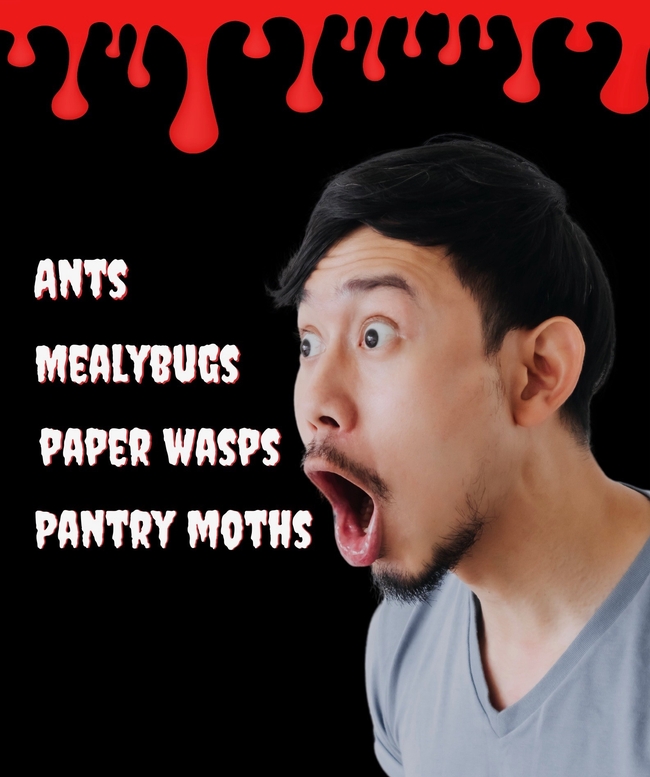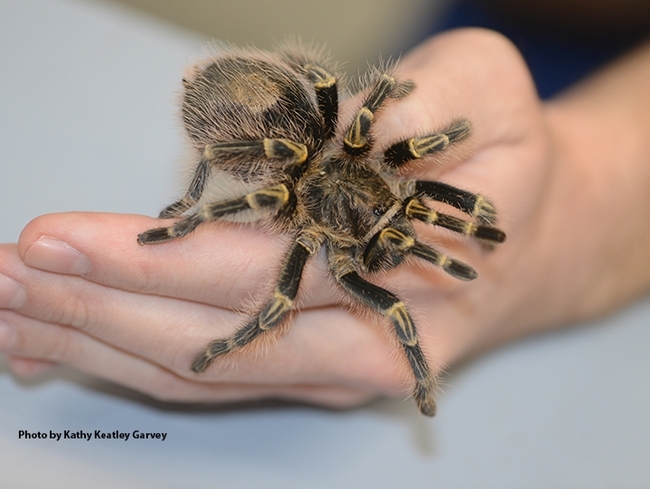
With Halloween coming up I am seeing lots of scary faux spiders among front yard Halloween decorations. I must admit I am guilty of feeding into the arachnophobia that so many people have by placing a big fake hairy tarantula in my yard.
Fascinating Creatures
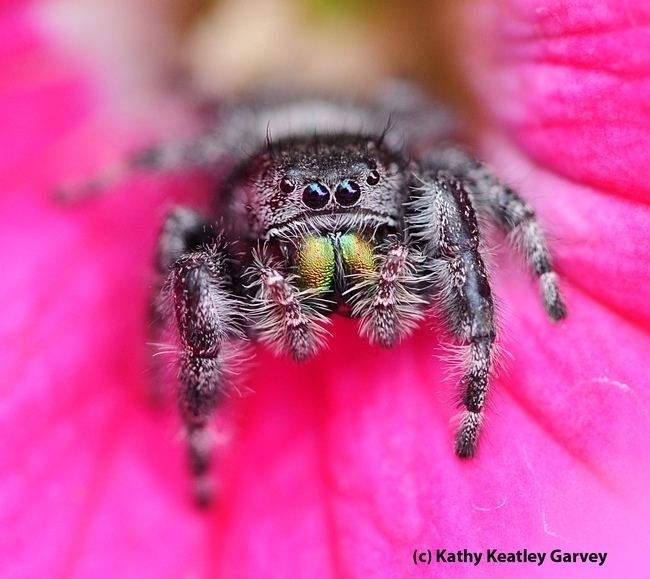
Most spiders are solitary creatures, but some form groups and even cooperate in brood care, caring for other spiders' offspring.
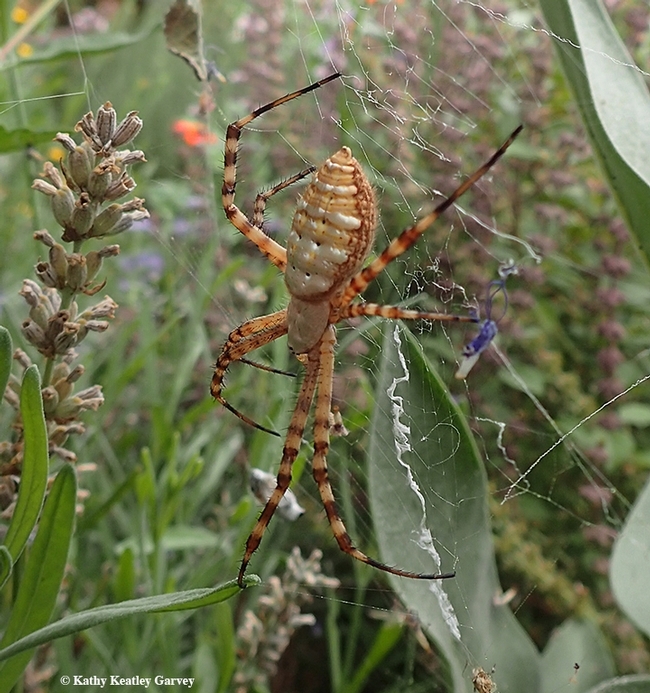
Not all spiders spin webs but those that do can create an incredible assortment of web designs, depending on the species, including spiral orbs, funnels, tubular, or ground sheets.
In some cases, two or more males will perform for a female to compete for her favor.
Some drop their silk to act as parachutes so they can drift on the slightest breeze
While spiders do not have brains in the traditional sense, a type of jumping spider appears to remember similar prey it has encountered, using trial and error to determine what works in capturing it.
Common and Beneficial
Spiders are the most common miniature living things living in our homes (besides micro-organisms). We are seldom aware of them because they conceal themselves in hidden spots (thus camouflaging themselves from their prey), tend to be active at night, and avoid humans. After all, we are much bigger than they are!
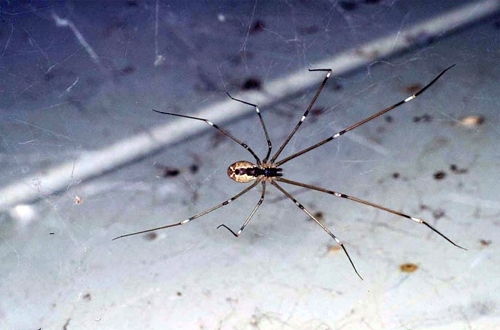
Spiders are beneficial organisms because they feed on common indoor pests such as mosquitoes, flies, roaches, earwigs, and moths. An additional benefit: many of the indoor pests that spiders consume can transmit diseases, i.e., mosquitoes, fleas, flies, and cockroaches. If left alone, spiders will consume most of the insects in your home, thus providing effective pest control.
Spider Bites
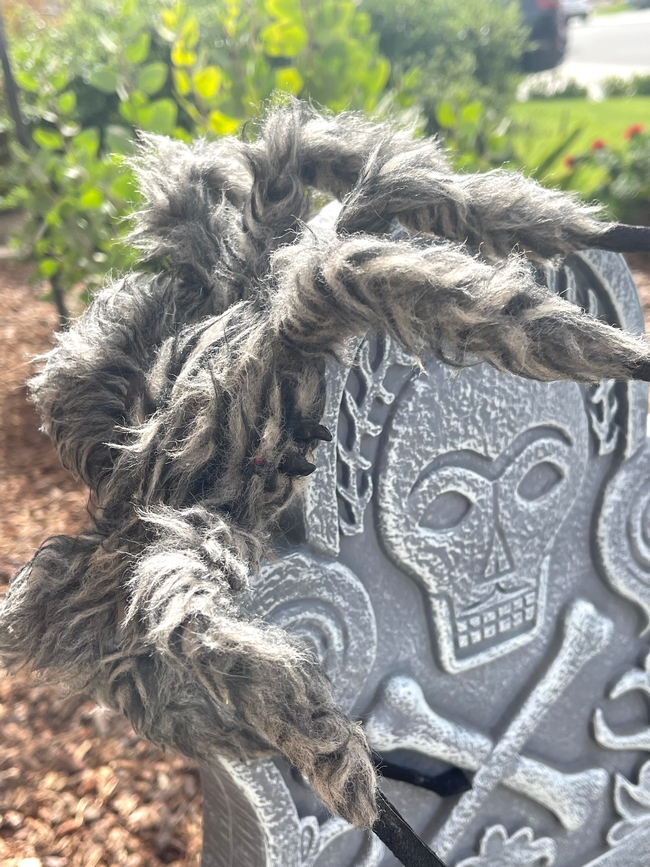
The jaws of most spiders are too small to bite humans. Of those that can bite, they will bite only if provoked, but very few spider bites are dangerous to humans. If you are bitten, the bite area may swell slightly and itch.
The adult female black widow is the primary spider in California capable of seriously injuring people. If bitten, remain calm and seek medical help.
Contrary to common myth, the brown recluse spider does not reside in California.
Managing Spiders
If you do have a spider issue around your home, the most effective way to manage them is to do regular housecleaning. Sweep or vacuum up their webs both indoors and outdoors, and prevent clutter build up that can provide hiding places for them both indoors and outdoors. If you do come across one, capture it in a jar and release it outside in an out-of-the-way spot. Avoid using pesticides since the chemicals will also kill other beneficial insects.
Appreciate Spiders Beneficial Role and Help Protect Them!
I will continue to put out my big “scary” tarantula out with the Halloween décor because spiders are so awesome. However, I do not put out the fake webbing, because like real spider webs, they can trap beneficial insects, spiders, and even small birds such as hummingbirds.
I will continue to allow spiders to share my home and garden, so they can do their crucial work of reducing pests. I much prefer having a few spiders around than mosquitoes, flies, moths, or cockroaches!
You do not have to love spiders like I do, but I hope you can appreciate the vital role arachnids play in our homes and gardens, and generally let them be.
References:
Spiders: https://ipm.ucanr.edu/QT/spiderscard.html
Pests of Homes, Structures, People and Pets: https://ipm.ucanr.edu/PMG/PESTNOTES/pn7442.html
Denise Godbout-Avant has been a UC Cooperative Extension Master Gardener since 2020.
The past few weeks have been “fun” with pest challenges in our garden and home. In the kitchen we battled ant infestations and pantry moths. In the yard the milkweed plants have been covered with oleander aphids, the California lilac (Ceanothus) was attacked by mealybugs accompanied by ants, and paper wasps (Polistes) have been trying to build a nest on the front porch.
How to tackle each of these issues? UC IPM (University of California Integrated Pest Management) Pest Notes and Quick Tips is my go-to for all these issues.
Inside the House:
Pantry Moths
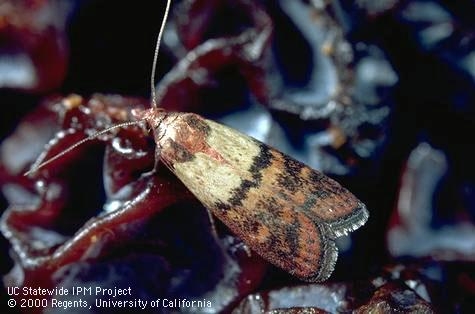
Ants
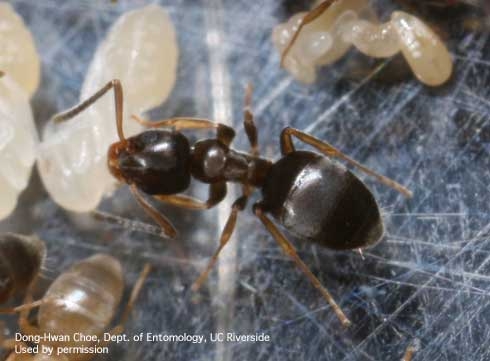
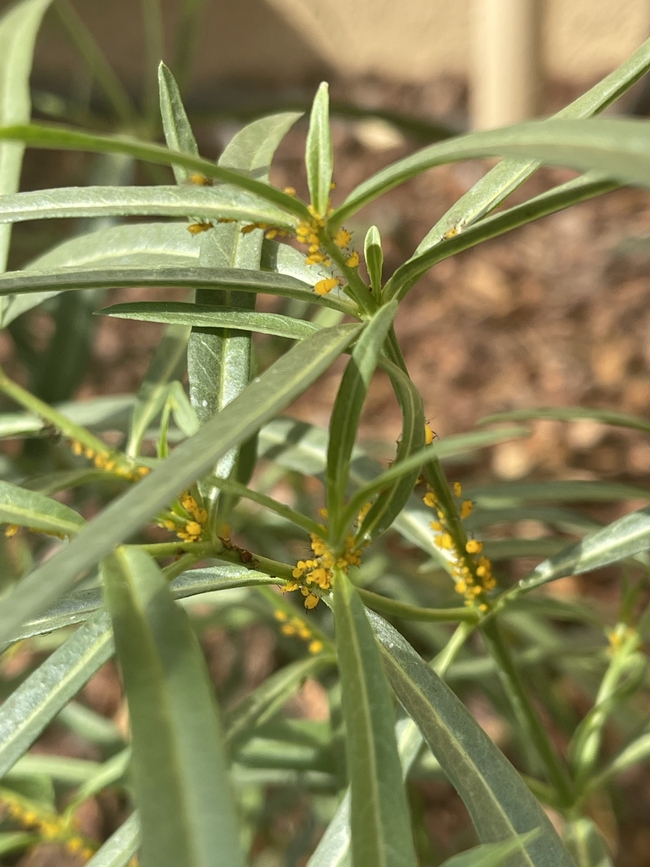
In the garden:
Milkweed and oleander aphids (Aphis nerii)
I hoped I had escaped getting the detested orange oleander aphids this year, since in recent years they usually showed up earlier in the summer, but ultimately, they appeared. Most established plants can tolerate some aphids, but all aphids produce honeydew, which can attract ants and sooty mold. Since milkweed is the sole food source for the Monarch butterfly caterpillar, pesticides are not recommended. Thus, using strong sprays of water every couple of days helps manage them. Based on previous experience, I know they will reach the end of their life and ultimately disappear. https://ipm.ucanr.edu/QT/aphidscard.html
Mealybugs (Pseudococcidae)
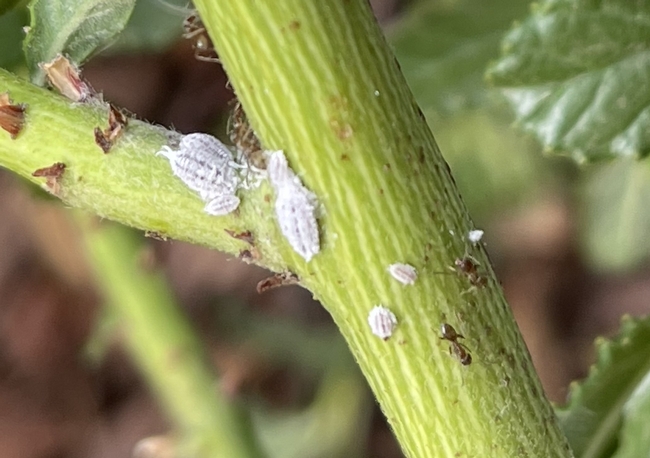
Paper wasps (Polistes gallicus)
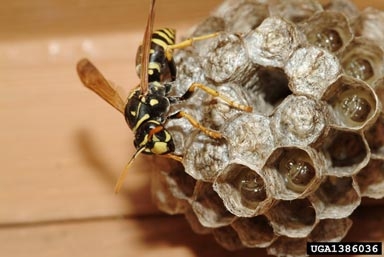
Thanks to UC IPM, which provides information on garden issues and pests, along with giving scientifically researched options on how to deal with them, I have managed to either control or eliminate these pesky pests.
UC IPM Resources:
The above links are to Quick Tips, short, to-the-point cards on each topic. They are available for free at local UC Cooperative Extension offices. The references below are for Pest Notes, which may have multiple pages and offer more detailed information about each topic.
Ants: https://ipm.ucanr.edu/PMG/PESTNOTES/pn7411.html
Pantry Pests: https://ipm.ucanr.edu/PMG/PESTNOTES/pn7452.html
Aphids: https://ipm.ucanr.edu/PMG/PESTNOTES/pn7404.html; https://ipm.ucanr.edu/PMG/PESTNOTES/pn7410.html
Mealybugs: https://ipm.ucanr.edu/PMG/PESTNOTES/pn74174.html
Wasps: https://ipm.ucanr.edu/PMG/PESTNOTES/pn7450.html
Denise Godbout-Avant has been a UC Cooperative Extension Master Gardener with Stanislaus County since 2020.

- Author: Anne E Schellman
If you've been startled by insects crawling in a food package or moths flying around your kitchen, you might have a pantry pest infestation. These insects are brought into your home inside food packages such as nuts, grains, cereal products, and even chocolate!
Meal Moths
This distinctive looking moth flutters around your kitchen, distracting you from the real culprit, their larvae. These caterpillar-like insects do all the real damage when they feed inside packages of cereal, flour, rice, dried fruit, candy, and nuts. You might also see tiny webs inside packages, this is the silken cocoon of the insect before it changes into a moth. Killing off the moths won't solve your problem.
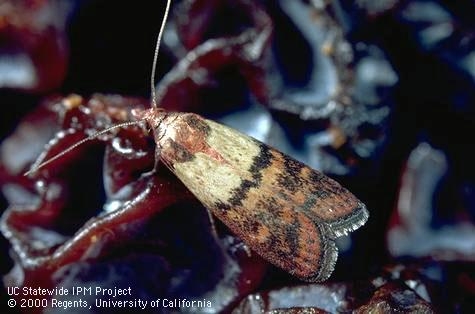
Beetles
There are several beetles that infest food, including warehouse beetles, grain beetles, cigarette beetles, and flour beetles. They feed on a variety of products including bird seed, pet food, tobacco products, animal hair (like wool), dried herbs and spices, dried meat and fruit, and even rodent bait.
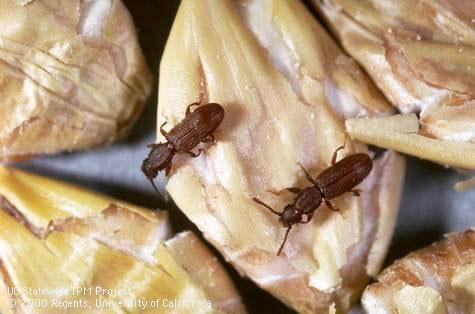
What Should You Do?
Although it might feel satisfying, spraying a pesticide is not an effective way to get rid of these pests. First, find the source of the problem. Look through all grain products and packages in your kitchen, especially opened packages. When you find the pests, seal the packages and throw them away. Remove everything from your shelves and wipe with soapy water to kill pests. Vacuum any crevices where pests or pest eggs may be hiding.
Fun Video
Watch this short video below from UC IPM for more detailed information on dealing with pantry pests. You can also read in more detail in the UC IPM Pest Notes: Pantry Pests.
- Author: Anne E Schellman
You may have heard a lot of “buzz” about pollinators lately. Declining pollinator numbers have caused concern among gardeners in California, prompting them to ask the UCCE Master Gardener program how it can help. But instead of us just telling you about pollinators, let's test your knowledge about them with a fun quiz!

Question #1: What is pollination?
Question #2: Which of the following are pollinators?
- (European) Honey bees
- Flies
- Wasps
- Butterflies
- Moths
- Hummingbirds
- Dragonflies
- Rats
- Native bees
- Snakes
- Beetles
Question #3: What 3 important things do you need to provide in your garden to support pollinators?
Write down your answers and then read tomorrow's blog post to see how well you did! Our next post will feature the answers to help you plan a pollinator garden. Also, look for a free class from us this summer or fall on pollinators. Subscribe to our blog and follow us on Facebook and twitter so you don't miss it!


